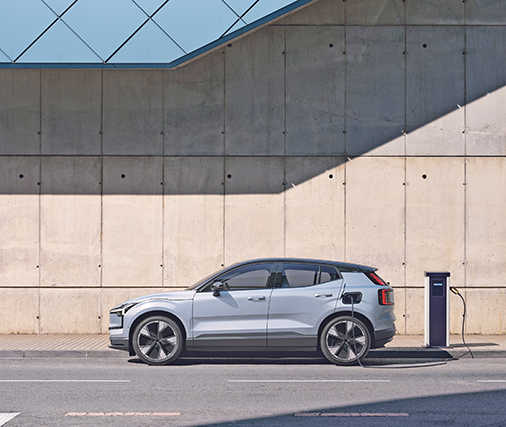Volvo Cars launched its new fully electric small SUV, the EX30, on June 7 with two powertrain options available in the U.S. It punches well above its weight class, offering a blend of performance and affordability with a starting price of $34,950, making it a very attractive choice.
This model is strategically positioned as Volvo’s entry-level electric SUV, primarily targeting a younger audience.
The EX30 is built on the Sustainable Experience Architecture (SEA) electric platform developed by Geely. The single-motor, RWD Extended Range variant, delivers 268 hp and a range of 275 miles.
If you’re seeking more power and performance, a dual-motor AWD variant is available. This configuration provides 442 hp and a slightly reduced range of 265 miles. Zero to 60 mph acceleration is just under 3.4 seconds, making it the fastest model in Volvo’s lineup and one of the swiftest SUVs in the electric vehicle industry.
Both variants feature a 64.0 kWh battery pack. Volvo claims a peak charging rate of 153 kW, allowing for a rapid DC fast charge from 10 to 80 percent in only 27 minutes.
There will also be an upcoming Cross Country variant, which will showcase an off-road-inspired appearance, featuring increased ground clearance, dual skid plates, and knobbier tires.
| Single Motor Extended Range | Twin Motor Performance | |
| Powertrain | Rear-mounted electric motor | One front and one rear electric motor |
| Power | 268 hp | 422 hp |
| Torque | 253 lb ft | 400 lb ft |
| Battery | 64 kWh | 64 kWh |
| Range | 275 miles | 265 miles |
| 0 to 60 mph | TBA | 3.4 seconds |
Volvo aims for half of its sales volumes to be EVs by mid-decade and to only sell EVs by 2030. According to them, the EX30 is one of its biggest business opportunities in the coming years.
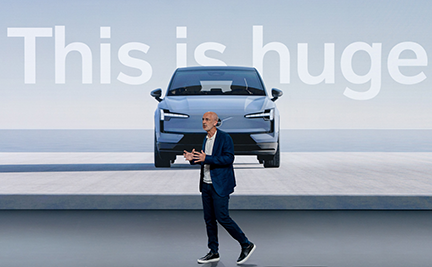
“It’s a big deal—a small SUV doing Volvo things,” CEO Jim Rowan said during the car’s launch event in Milan, Italy.
“Customers get a premium fully electric SUV for a price similar to combustion engine-powered equivalents,” Volvo said.
The EX30 will be produced in the Zhangjiakou plant in China—operated by Geely—and production will start later in 2023.
The new model is available for order in Europe as of now with deliveries beginning early 2024. In the U.S., customers can place pre-orders, while deliveries will begin next summer.
As a result, the EX30 will be delivered earlier than the EX90, Volvo’s large EV SUV, which was unveiled last November. The EX90 will start production in the first half of 2024 due to production delays.
Interior
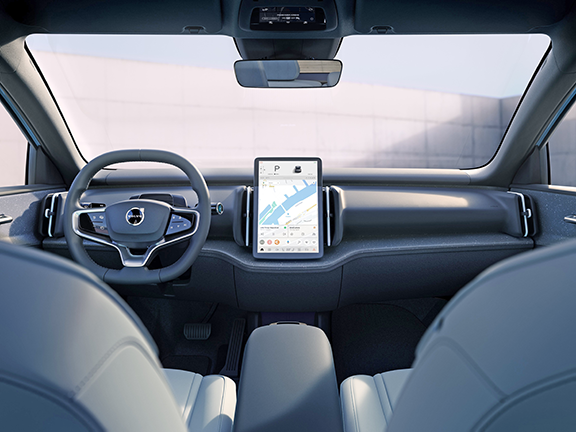
The EX30 dashboard houses the centrally located 12.3″ tablet-style display, which keeps driver information at a glance with your favorite controls on the same screen. It is accompanied by a soundbar positioned under the windshield. It’s worth noting, however, that the EX30 does not come with an instrument cluster behind the steering wheel or a heads-up display.
Google apps and services are built in, which means you can connect to your digital life without pairing your phone to the car. Google Assistant can be used to control some car functions, make calls and send texts, check opening hours, and do the same quick searches you do on your phone. Navigation is handled by using Google Maps.
The window switches have been moved to the center console, which also features a sliding system that offers customizable storage space.
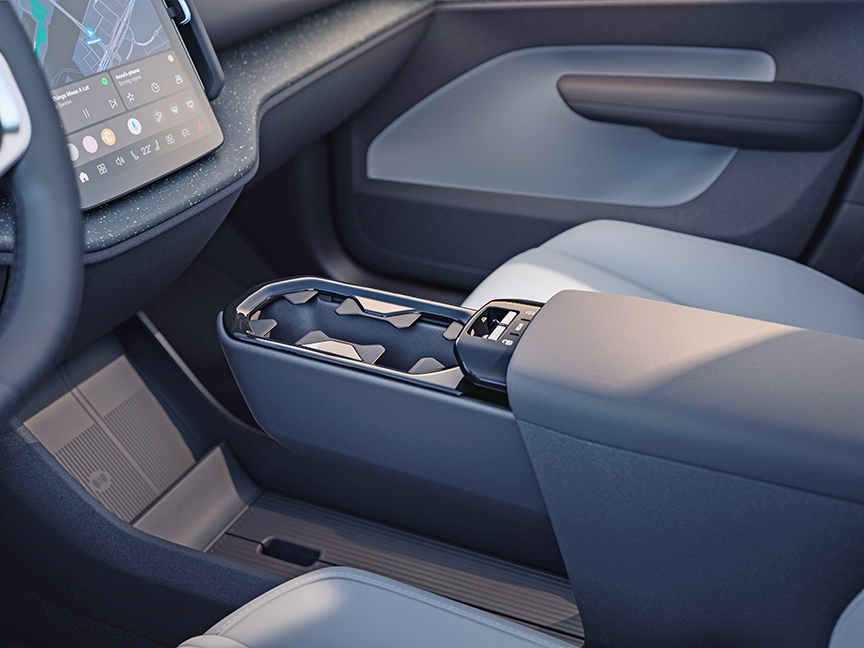
The interior components, such as seats, dashboard, and doors, are composed of approximately 70 percent recycled and renewable materials. The EX30 also incorporates a significant percentage of recycled steel and aluminum (17 and 25 percent, respectively). The interior embodies sustainability by utilizing re-purposed materials, such as recycled window frames and bio-attributed components sourced from Scandinavian forests.
Safety
The EX30 uses rear radars to detect cyclists and scooters approaching from behind, sounding an alert if someone in the car is about to open a door. The alert has two levels. First, you’ll hear a warning on the center display and a steady BLIS (blind spot information system) light. When a collision risk is imminent, the alert escalates. You’ll hear a warning sound and the BLIS light will flash.
There is also a new generation of the Park Pilot Assist feature, which can handle all types of parking spaces. The EX30 can steer, accelerate, and brake to take care of most of the parking itself—it can even parallel park. Just keep a sharp eye on what’s going on around you and take over if something unexpected happens. The car will find good parking spots, too. At speeds up to 14 mph, it can locate spaces and show your options on the center display. Pick one, and the car will do the rest.
Although the EX30 does not incorporate Lidar systems found on the flagship EX90, it retains Volvo’s commitment to delivering a safe and technologically advanced experience for drivers and passengers.
Here’s what’s included:
- Parking Assist
- Blind Spot Monitoring
- Lane Keep Assist
- Auto High beam
- Door Opening Warning
- Driver Drowsiness/Attention Warning
- Emergency Lane Departure Avoidance
Markets
Volvo sees Europe as the most important market for the EX30, but it will be built only in China—in a Geely plant together with other brands. That goes against the strategy of building where you sell and creates an extra vulnerability in today’s global trade tension environment.
“It was an opportunity for us to get started quickly,” says chief operating officer Javier Varela.
Since Geely became the owner of Volvo Cars in 2010, the company has built up a global production apparatus where the manufacturing plants in Sweden and Belgium have been joined by three car factories in China and one in the U.S. The strategy has been to build car models that suit each market, which has been more or less successful depending on the timing.
The U.S. factory, for example, has been running at half speed for a long time because the only model built there, the S60, has lost its appeal. The plant is now being retooled to produce the EX90—the new large electric SUV—a car that is expected to attract many customers in the U.S.
The factory in Ghent, Belgium is going full blast and building the only electric car models that Volvo has on the market so far, the XC40 and C40.
In the production puzzle, Volvo does not have the capacity to quickly get started with the EX30. The car will instead be manufactured in a Geely factory in Zhangjiakou, China.
“There is a lot of flexibility in that factory where different brands are built, but the fact that we choose this solution is not a change in our strategy,” says Varela.
According to Björn Annwall, chief commercial officer, the choice of production in China is also cost driven.
“We get the costs down because we use the Geely-shared SEA (Sustainable Experience Architecture) platform, presented in 2020 and designed to be electric. It also allows us to share the cost of production tools with other brands, such as Smart and Zeekr,” he says.
There are no plans yet for manufacturing the EX30 in Europe. The new electric car factory to be built in Slovakia should be ready in 2026 and is then expected to produce a completely new electric car model.
“I am quite convinced that over time the EX30 will be very successful, so a little further on we will have to think about how we continue to globalize the production network for this car,” says Annwall.
It is becoming increasingly clear how Volvo Cars is woven into the Geely group both in terms of model development and production planning. An outright merger with sibling brand Geely Auto was called off a couple of years ago because there were deemed to be too many risks for both brands. But a deepened collaboration was already announced then.
Which target groups is the EX30 aimed at?
“It is younger customers who may be buying their first car. I also think, especially in Sweden, that there are families who may have several cars and have not dared to switch to electric but can now choose to do so and have this car as a second car. We also believe that many older people are attracted by a smaller car.”
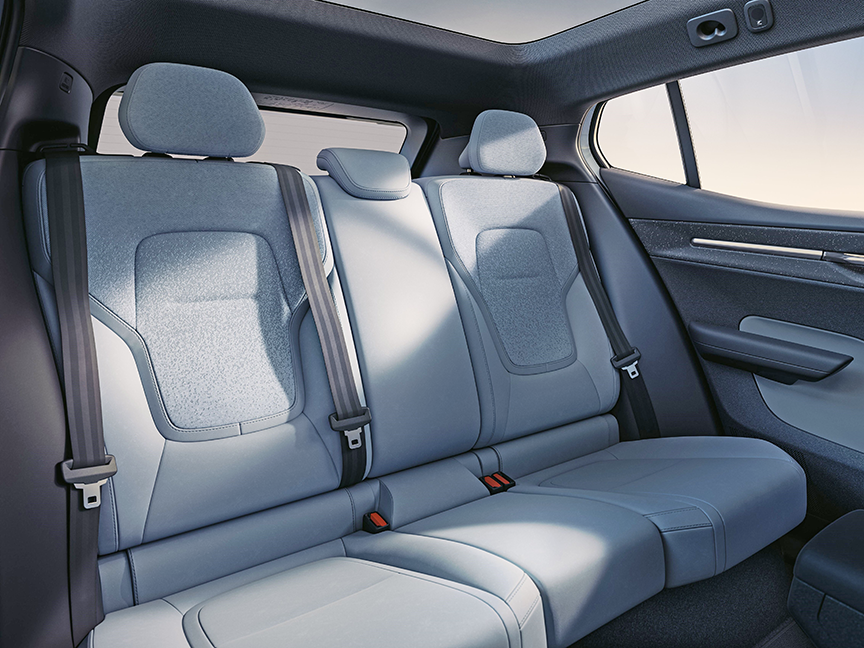
The car will be launched globally, but Volvo expects it to do best in Europe.
“We think it will be huge in Europe, but we also see great demand in Latin America and the U.S.,” says Annwall.
Volvo Cars has set the goal of selling 1.2 million cars by the middle of the decade. This means almost doubling last year’s sales, when the company struggled with delivery disruptions and did not get cars out at the desired rate. The goal is also for half of the production to be electric cars.
When Volvo has been able to increase production speed again this year, the great demand for electric cars is noticeable above all in Europe. Almost every third Volvo car sold there is electric. In China, on the other hand, Volvo is having a tough time with competition from domestic electric car companies. So far this year, only two percent of Volvo’s sales are pure electric cars in China.


